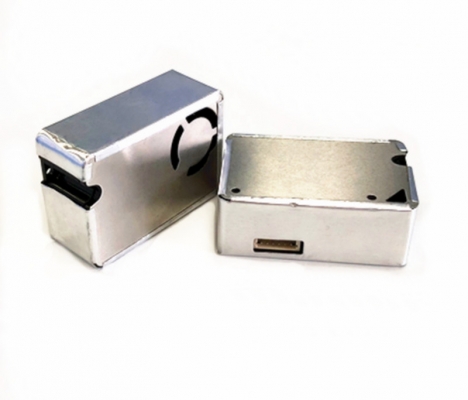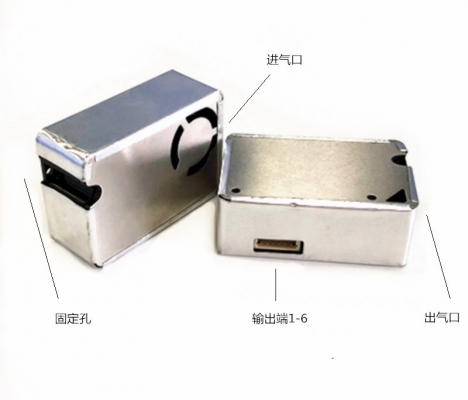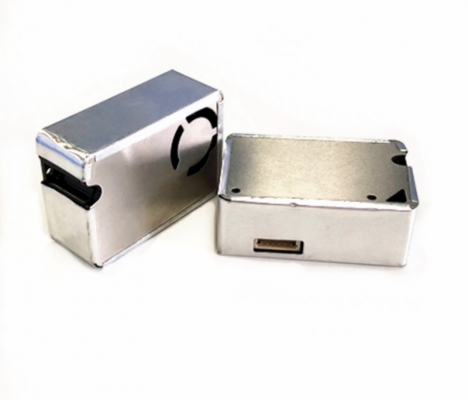Detail: HW210 Laser Digital Dust Sensor
Description
Features:
Digital output dust concentration signal output unit μg/m3;
Built-in microprocessor MCU optimized precise algorithm; standard serial port output;
Digital PWM pulse width output and standard serial port (USART);
Built-in software self-calibration function, simple debugging, high efficiency and accuracy, good consistency;
Light particle counting principle, digital output, simple application, universal interface;
high sensitivity can detect particles with a diameter of 1μm or more;
Compact structure, light weight (W48.1xH17XD32.3 mm), embedded installation;
Using active air flow structure, real-time data characteristics;
Dual air inlet structure, suitable for more design, convenient installation;
Product principle overview:
SY210 is a laser optical refractometer that detects the number of dust particles in the air and has an embedded MCU
Digital dust sensor for digital detection of real-time environment dust concentration by outputting directly from the operating system and outputting data
Unit μg/m3. Intersecting the laser light source with the optical axis of an image sensor when dusty airflow
Reflected light is generated through the intersection area. The image sensor detects dust reflected laser light, according to precision
High-speed op amp amplification and internal modulation circuit and MCU count and algorithm, operation system particle number and weight conversion,
Direct output of digital signals of dust concentration, this sensor can sensitively detect particles with a diameter of 1.0μm or more,
Repeatedly optimized and precise data processing through the built-in microprocessor MCU has greatly improved the accuracy.
Directly output PM2.5 concentration signal in the current environment, unit μg/m3
Detection and application areas:
Air purifier, air refresher
Air dust detection, indoor air dust quality detection;
Home appliances, air conditioners, HVAC, new fans,
Ventilation system, smoke alarm or other dust monitoring equipment detection components
As non-metering instrument detection components (Note: This product does not require high reliability, safety, precision
Equipment and measuring instrument components);
Electrical parameters:
Specifications
|
No. |
Parameter |
Specifications |
|
1 |
Supply voltage |
DC5V±5% ( CN1:Pin1=GND, Pin2=+5V ) |
|
2 |
Power Consumption |
50mA ± 10% |
|
3 |
Working temperature and humidity |
‐10~55°C, 95% RH or less (without condensation) |
|
4 |
Storage temperature |
-30°C~60°C |
|
5 |
Detection particle diameter |
1μm or more |
|
6 |
Detection of dust particle concentration range |
5~990μg/m3 (PWM output mode) |
|
7 |
signal output |
PWM output in μg/m3/USART serial output
Output level: LOW=0V, HI=4.0V |
|
8 |
dimensions |
W48 .1x H17 x D32.3 (mm) |
|
9 |
weight |
about 30g |
|
10 |
Measurement start time |
Approx. 1 minute after power on (system internal correction time) |
Sy210 dust sensor output definition: n
n
Connector pin definition
|
No. |
Name |
Pin Description |
|
1 |
GND |
Power Input (ground) |
|
2 |
+5V |
power input (+5V terminal) |
|
3 |
PWM |
dust data PWM pulse width signal output 1UG/M3=1mS, period 1S |
|
4 |
NC |
internal inspection, not open to users; can be vacated |
|
5 |
NC |
NC internal inspection, not open to users; can be vacated |
|
6 |
TXD |
USART Output. Open |
Note: Connector specifications: A1500WF-06A, spacing 1.5mm6PIN
Data reading method (communication protocol)
A, PWM communication interface:
The PWM interface outputs a periodic pulse signal with a period of 1S, low-level duration of each period
It is proportional to the PM2.5 concentration value detected by the current module. The low level 1ms = 1ug/m3*K;
Read mode: Waiting for counting at high level, counting at low level (no 1mS plus one) when high
When the level is reached, the counting is stopped. This count value is both the PM value and the high level continues to wait and repeat the measurement.
The waveform is as shown in the figure below: Reference graph (specific actual maximum value, see different product specifications)




 客服微信
客服微信